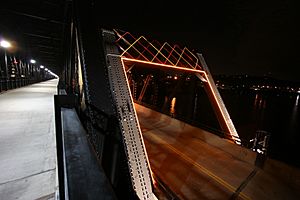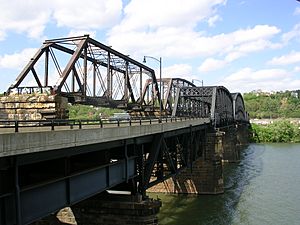Hot Metal Bridge facts for kids
Quick facts for kids Hot Metal Bridge |
|
|---|---|

Roadway south portal from the bike trail.
|
|
| Coordinates | 40°25′42″N 79°57′39″W / 40.428268°N 79.960776°W |
| Carries | South 29th Street Mon Con: motor vehicles, 2 lanes Hot Metal: converted for pedestrian and bicycles |
| Crosses | Monongahela River |
| Locale | Pittsburgh, Pennsylvania |
| Official name | Monongahela Connecting Railroad Bridge and Hot Metal Bridge |
| Other name(s) | MC RR Bridge, Mon Con Bridge, pghe588-14 |
| Characteristics | |
| Design | Truss bridge |
| Total length | 1,174 feet (358 m) |
| Longest span | 321 feet (98 m) |
| Clearance below | 48.4 feet (14.8 m) |
| History | |
| Designer | William Glyde Wilkins? |
| Opened | 1887 |
| Designated | 2009 |
| Lua error in Module:Location_map at line 420: attempt to index field 'wikibase' (a nil value). | |
The Hot Metal Bridge is a famous truss bridge in Pittsburgh, Pennsylvania. It crosses the Monongahela River. This bridge is special because it has two parts built side-by-side on the same supports.
The first part, built in 1887, was for regular trains. It was called the Monongahela Connecting Railroad Bridge. The second part, built in 1900, was the original Hot Metal Bridge. It carried huge pots of melted iron from one part of the J&L Steel factory to another. This melted iron was then turned into steel. During World War II, a lot of America's steel was made using iron that crossed this bridge.
The Hot Metal Bridge connects 2nd Avenue in South Oakland to Hot Metal Street (South 29th Street) in the South Side of Pittsburgh.
A Bridge with Two Lives
The Hot Metal Bridge is actually two bridges built very close together. The older part, finished in 1887, was for regular railroad trains. It helped move goods and materials around.
The newer part, built in 1900, was the real "Hot Metal Bridge." It had a very important job for the J&L Steel mill. It carried giant pots of super hot, melted iron. These pots traveled from the blast furnaces on one side of the river to other furnaces on the opposite side. There, the melted iron was turned into strong steel.
During World War II, this bridge was incredibly important. About 15% of all the steel made in America crossed over the Hot Metal Bridge. That's a huge amount of steel, up to 180 tons every hour! This steel was vital for making tanks, ships, and other things needed for the war.
From Steel to Trails
After many years of carrying trains and hot metal, the bridge got a new purpose. One of its spans was changed to carry cars. This big project cost $14.6 million. It opened on June 23, 2000, with a special ceremony. The ceremony honored the people who used to work in the steel mills.
The other span of the bridge was also updated. In late 2007, it opened for people to walk and ride bikes. This part of the bridge is now a section of the Great Allegheny Passage. This is a long trail for hikers and bikers. It helps them get closer to Pittsburgh's Golden Triangle area.
Lighting Up the Night
The Pittsburgh History and Landmarks Foundation helped make the bridge look beautiful at night. They managed a project to add special lights to the bridge. On June 12, 2008, the bridge was lit up using energy-saving light-emitting diode (LED) and optical fiber technology. This makes the bridge glow and stand out in the Pittsburgh skyline.
A Hall of Fame Bridge
The Hot Metal Bridge is so important that it was recognized in a special way. In 2016, it was added to the North America Railway Hall of Fame. This honor celebrates its history and its role in transportation and industry.



